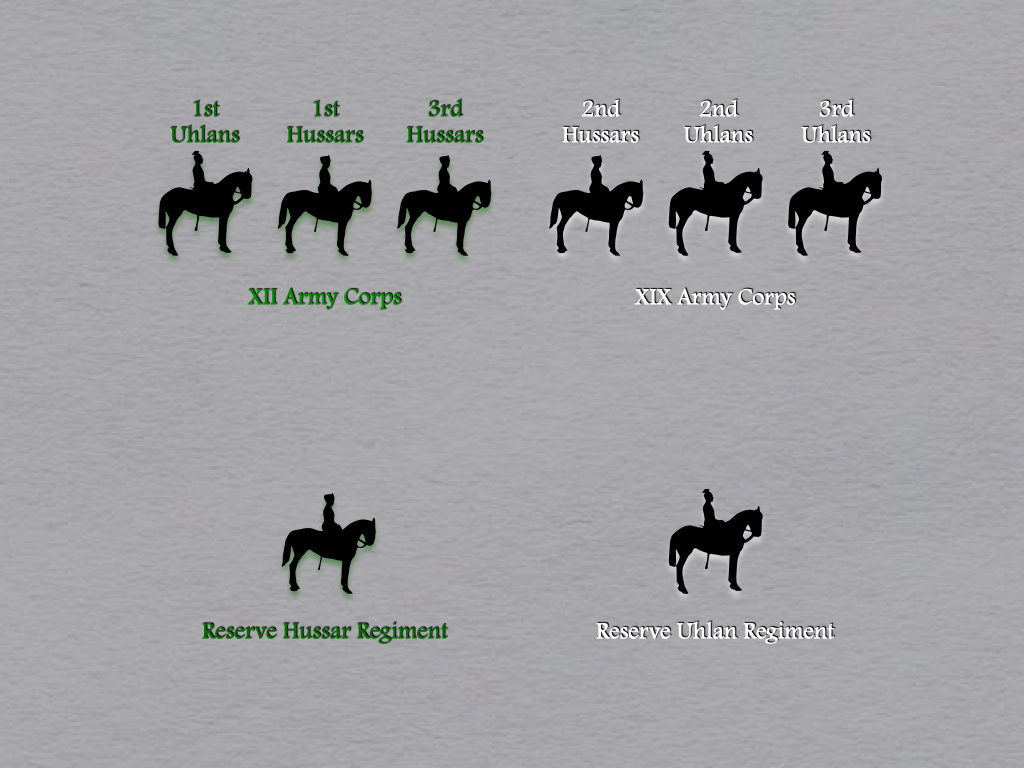At the start of the First World War, the German Empire mobilized 654 active infantry battalions and 642 second-line infantry battalions. Thus, in rough terms, it raised one second-line battalion for every active battalion. At the same time, the German armies raised 452 active cavalry squadrons and 149 second-line cavalry squadrons. Thus, the ratio of active squadrons to second-line squadrons was three to one.
Most of the second-line squadrons were assigned, at a rate of 3 squadrons per regiment, to one of the 33 Reserve cavalry regiments. Of the latter, 29 were assigned to Reserve infantry divisions of the ordinary kind, 3 to the “main reserve of a fortress” reserve divisions, and 1 to the fortress of Königsberg.
Of the Reserve cavalry regiments, 10 were characterized as dragoons, 9 as hussars, 8 as uhlans, 3 as “heavy riders” [Schwere Reiter], 1 as “mounted rifles” [Jäger zu Pferde], and 2 simply as “cavalry.” Thus, at least where naming conventions were concerned, no Reserve cavalry regiments corresponding to the cuirassier regiments of the Prussian Army or light horse [Chevaulegers] regiments of the Bavarian Army. Moreover, while the title of the reserve unit often reflected that of the peacetime unit that formed it, many of its members, whether recalled reservists or seconded professionals, had previously been horse soldiers of a different sort.
The regiments of Schwere Reiter, all three of which were raised by the Prussian Army, enjoyed no particular connection to the Schwere Reiter regiments of the peacetime establishment of the German Empire, both of which belonged to the Bavarian Army. Thus, for example, most of the men in the ranks of the 2nd Reserve Heavy Rider Regiment (2. Schwere Reserve Reiter Regiment) had spent their peacetime service with either the 8th Cuirassier Regiment or the 7th Hussar Regiment. The provenance of the senior leadership of the 2nd Reserve Heavy Rider Regiment was even more diverse. The regimental commander wore the uniform of the 5th Cuirassiers, the senior squadron commander that of the 7th Mounted Rifles.1
The relationship between Reserve cavalry regiments and particular army corps varied greatly. In the XIII Army Corps, which consisted entirely of units belonging to the army of the Kingdom of Württemberg, all four of the peacetime cavalry regiments - two of dragoons and two of uhlans - sent reservists to the Württemberg Reserve Dragoon Regiment. (As uhlans tended to be taller than dragoons, some of the reservists who had served with uhlan regiments found it hard to fit into the dragoon uniforms issued to them.)2
The Saxon Army, which had three peacetime uhlan regiments and three peacetime hussar regiments, solved this problem by sending recalled uhlans to the Royal Saxon Reserve Uhlan Regiment and recalled hussars to the Royal Saxon Reserve Hussar Regiment.3 (In order to do this, the Saxon War Ministry had to transfer about a third of the reservists of each type from the jurisdiction of one army corps to another.)

The Bavarian Army took a very different approach. It took formed reservists who had served in its 2 uhlan, 2 heavy rider [Schwere Reiter], and 8 light horse [Chevaulegers] regiments into two generic Reserve cavalry regiments. (The relatively high ratio of active regiments to Reserve regiments may have been a function of the relatively small size of the cavalry establishment of the peacetime Bavarian Army.)4
Fritz Najork, Die Geschichte des Schweren Reserve Reiter Regiments Nr. 2 (Berlin: Gerhard Stalling, 1930) pages 12 and 13
Fritz Klett, Das Königlich Württembergische Reserve-Dragoner-Regiment (Stuttgart: Belser, 1935)
Georg Jaeckel, Das Königlich Sächsische Reserve-Husaren-Regiment (Dresden: Gebrüder Arnold, 1934) page 11
In 1905, the three army corps of the Bavarian Army, which should have possessed a total of 60 peacetime squadrons, had but 53. In 1913, the number of peacetime squadrons had increased to 57. Löbell’s Jahresberichte, 1905 (page 5) and 1913 (page 4)



